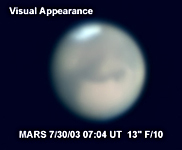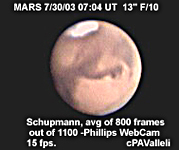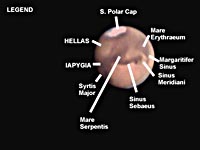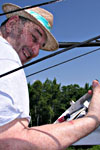

All images on the Stellafane Astrophoto Pages are the property of the credited owner.
Paul Valelli's Astrophotos
Member of the Springfield Telescope Makers
Link to Paul's 2002-Sep-07 Aurora Photos
Mars Images from the Schupmann Telescope
Images acquired 2003-Jul-30 UT
 Visual Appearance |
 Average of 800 Images |
 Legend |
 Paul Valleli |
While up at Stellafane for pre-convention preparations, I spent some early morning times, experimenting with different videography setups on the 13" F/10 Schupmann at the McGregor Observatory. On the mornings of July 26th and 27th I tried the Meade B&W "Electronic Eyepiece" ( 340 X 280 pixels) but it did not work because it does not have a brightness control. Mars was too bright and would have required neutral density filters. That didn't make much sense! I put that EP away and tried eyepiece projection with my Hi-8 Sony HandyCam. I was trying 32mm and 40mm Plossl's. There was a tracking problem with the mount and as the planet drifted across the field, there was a lot of vignetting evident. I had also noticed that problem on sunspots when I did some solar photography in May. We had just cleaned the optics in preparation for convention. Next time, I will try 12mm and 9mm projections.
Images of Mars looked promising for size and exposure, if I could just get the tracking rate under control. After two days back at work, I returned on Tues. night, the 29th and found that the "software/hardware experts" had figured out what was wrong. I decided to hold off using my SBIG CCD in favor of the much easier to control Phillips ToUCam. This webcam sends images directly to a laptop via a USB port. Mars was now in my sights. I ran sequences of one to four minutes at prime focus with the images going directly on the 40 Gig hardrive of my Sony Laptop. What was great was that other observers could look over my shoulder to see what I was recording.
I judged the seeing to be about 7, with some wander of the planetary disk and faint details appeared periodically when the high-frequency turbulence subsided. We quickly established that we were seeing the Syrtis Major region and Sinus Sabeus was coming into view. I was somewhat disoriented because the Schupmann has three mirror reflections and, therefore, presents a mirror image to the screen. The Hellas region was rotating of the visible disk and I was relieved that no major dust storm had yet erupted. I acquired about ten thousand frames by 3AM, at which time a breeze picked up and the seeing went to Hellas! Dog tired from standing on the ladder so long, I closed up the observatory and sacked out in the observatory attic. I awoke about 11 AM, in a sweat. I was dreaming I was in the tropical rainforest of Costa Rica and soldiers were firing machine guns in the distance. An uprising? No. John Martin and his crew were using the wood-hog chipper behind the observatory. Bert Willard and I checked out the optical alignment of the Porter Turret in the evening and then I went back over to Stellafane East. I tried to capture some more frames through holes in the clouds but the seeing was bad and things just got worse as Friday and convention time. Most of you know the rest of the story... it rained and rained, and Stellaflooded.
Last week I converted my files to .AVI format and picked out the best sequence of about 240 seconds. I then uploaded Reigstax software and picked the Sebaeus region as a reference area for FFT processing. After a 12 hour run on the 2.4 Gigahertz Sony, the computer had culled 700 decent frames. The next night it stacked them. I don't know how long that took... too tired and went to bed. Finally, I started the fun part of the project, using wavelets to eek out every bit of detail from those 700 frames. While I had visually seen two bright mountains in the polar cap and some dark divisions, indicating breakup is well along, there is only a hint of a rift in the processed image. However, the rest of the markings in the image reveal much that I could not resolve in the eyepiece.
I have said it before, thank goodness for New England weather. It allows astronomers time to process data. I will have to wait until another time to try out the SBIG camera but doubt that it will be better than the $90 webcam.
Clear, dark and steady skies... Paul Valleli
Back to the Astrophoto Index Page
All images on the Stellafane Astrophoto Pages are the property of the credited owner.